The Pacific Coast Herring Fishery
The long-standing Fisheries and Oceans Canada (DFO) policy to allow a Sac-Roe Fishery (SRF) harvest of herring eggs has always been incredibly wasteful and shortsighted. It is an industry that has triggered a cascading decline of economic, cultural and ecological well-being in B.C. The intensive reduction fishery started in the early 1930s and continued until all five major stocks collapsed in the late 1960s. Pacific herring populations recovered rapidly following a four year fishery closure but the species is prone to collapse and abundance has declined again recently, with little evidence of recovery. Using seine or purse nets to capture schools of pre-spawn herring, SRF boats can kill thousands of tonnes of fish in a matter of minutes. Of those huge catches, only the roe is removed for human consumption; the carcasses are treated as by-product and used to make feed tablets for fish farms, bait or put into garden fertilizers. As herring can spawn seven or eight times over their lifetime, this kill-fishery not only removes huge biomass from the overall herring population, but destroys their ability to reproduce in future years.
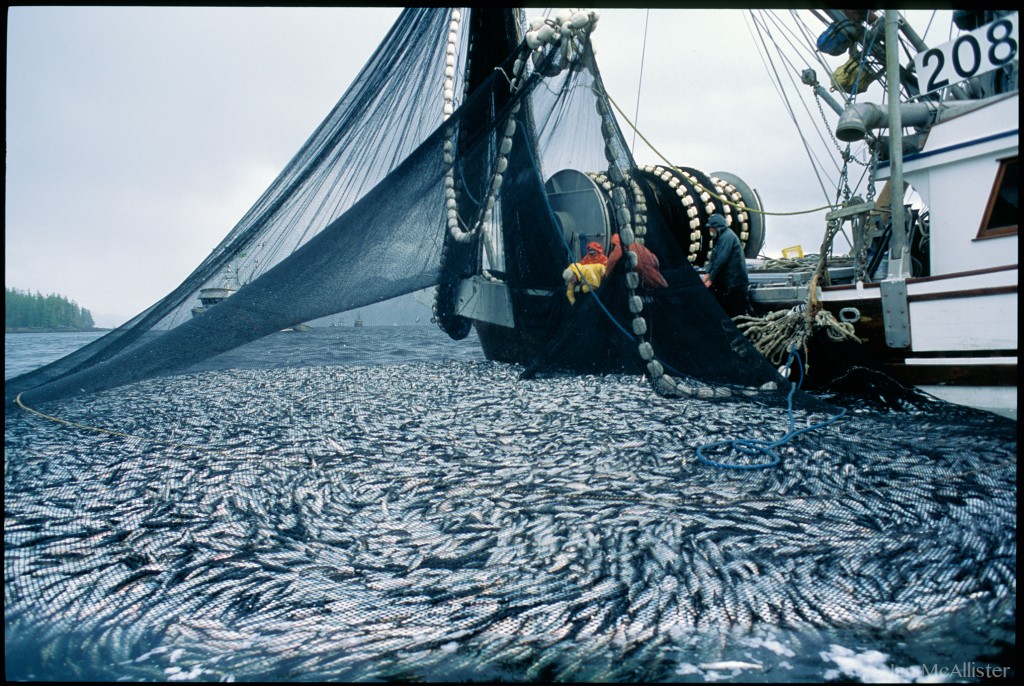 Herring captured in seine nets March 2015, photo by Ian McAllister
Herring captured in seine nets March 2015, photo by Ian McAllister
This fishery is systematically extirpating one of B.C.’s most important foundational and keystone species. Granted, there are many other wasteful industries in our country, but what makes this one so spectacularly so is the fact that there is a clear, effective, and sustainable alternative. It is not a new method of harvesting herring eggs, quite the opposite, it has been used along the B.C. coast for thousands of years. Herring bones that have been uncovered deep in the substrate of ancient village sites provides evidence of the long relationship between the first peoples of this coast and herring.
The Heiltsuk people today, like the countless generations before them, travel to the traditional herring spawning grounds in anticipation of the inshore herring migration. Heiltsuk families anchor logs and other flotation devices to the seabed and attach lines of hemlock branches or seaweed to them – essentially mimicking ideal herring spawn habitat. With luck, herring will see these branches and kelp fronds and choose them as a spawning location, after a few days multiple layers of eggs will coat the vegetation and the harvest can begin.
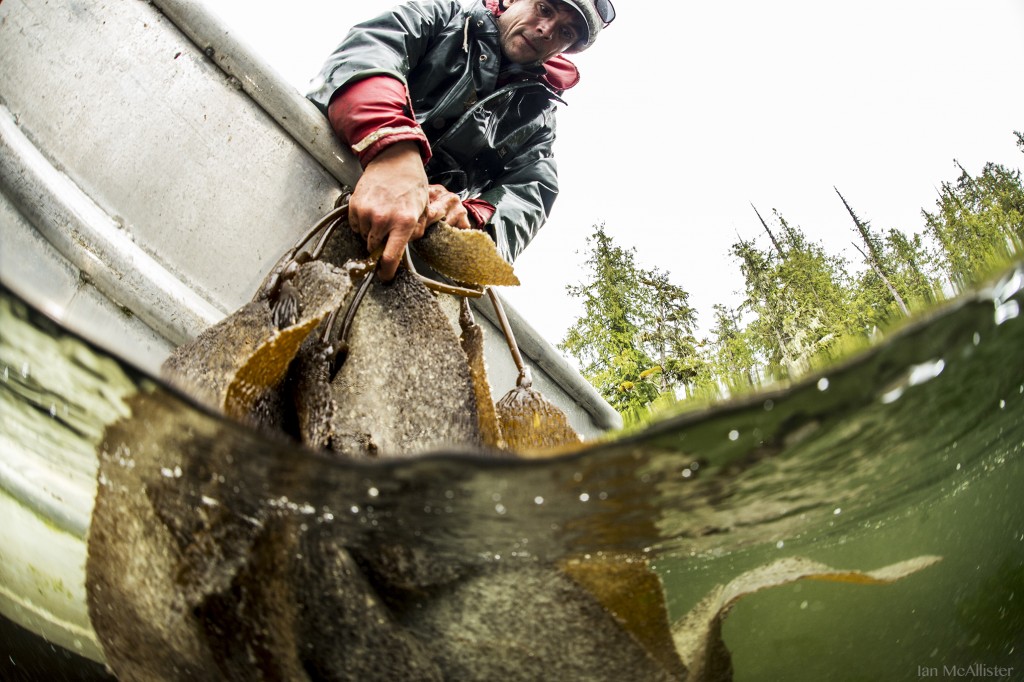 Spawn-on-kelp herring roe harvest. Kelp covered in eggs are pulled from the water on the central B.C. coast, photo by Ian McAllister
Spawn-on-kelp herring roe harvest. Kelp covered in eggs are pulled from the water on the central B.C. coast, photo by Ian McAllister
The Heiltsuk choose hemlock branches because of the needles’ flavour and medicinal benefits, but also because the natural resins provide a lot of sticky surface area for the eggs to attach themselves. Certain species of kelp are preferred over hemlock by some families, and spawn on kelp remains the main product used for export.
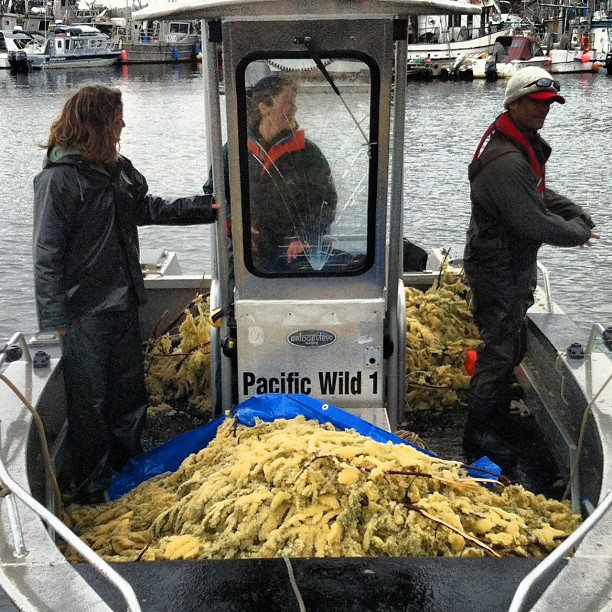 Hemlock branches coated with herring eggs, harvested near Bella Bella, B.C. Photo by Max Bakken
Hemlock branches coated with herring eggs, harvested near Bella Bella, B.C. Photo by Max Bakken
These days, as the world’s oceans are picked clean for human consumption, the words ‘sustainable fishery’ have lost their meaning. In contrast, this traditional fishery has a very small footprint. It also maximizes ecological and economic benefits as the herring get to live and continue to spawn for successive generations.
Compare this to the DFO industrial-scale kill fishery model and it becomes shameful that the Heiltsuk and other Nations have not been more supported for the long battle that they have been waging against DFO, both in the courts and by active blockades on the herring grounds – to shut this unsustainable fishery down. Like the east-coast cod and so many other fisheries that have collapsed at the hands of DFO, herring stocks here are following the same path and hundreds of traditional spawning areas in the territory have gone silent.
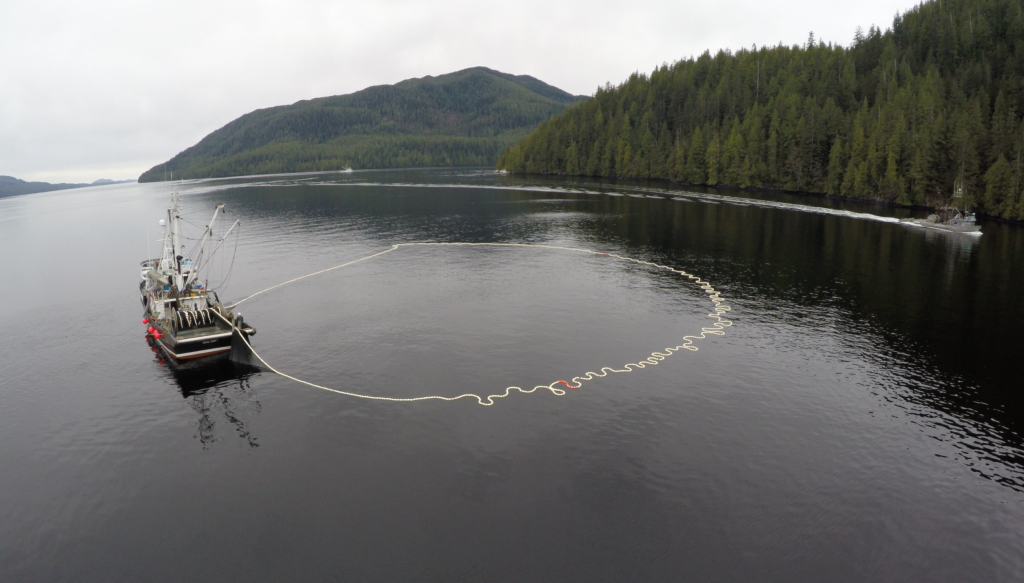 Seine nets set to harvest herring on the B.C. central coast, photo by Ian McAllister
Seine nets set to harvest herring on the B.C. central coast, photo by Ian McAllister
When the Heiltsuk fishers go out on the grounds they are bringing with them generations of experience and knowledge. The logic behind the SRF industry, however, hits a dead-end pretty quickly. One does not have to use much foresight to see that a fishery founded on the mass and unnecessary killing of future spawning populations is doomed to harvest itself into the ground. All of the hallmarks of hunter-overkill are evident with the herring fishery. More corporate control of the fishery, more technology being used with bigger boats and hi-tech sonars while the fish get smaller in size forcing more immature fish to be harvested. This not only destroys the fish with greatest lifetime spawning potential, it is not even profitable as immature fish (2-3 years old) have fragile stomach linings that burst before any roe can be harvested.
The DFO releases an annual ‘Pacific Herring Integrated Fisheries Management Plan’, which, on the surface, appears to be a comprehensive report. Reading ten years worth of these documents, however, only further convinced me that the DFO not only has a limited understanding of herring’s ecological importance, requirements, or how to safely manage them, they also don’t seem to care. Take this section of the 2004 report, for example: “At this time there is no information available on the appropriate conservation limits for the ecosystem as it pertains to the herring stocks”. It continues on to talk about harvest rates, and ends with: “Research is ongoing to better understand these ecosystem processes and the role herring plays in maintaining the integrity and functioning of the ecosystem.” This paragraph, on page two, appears sincere enough, a commitment to future herring research is definitely important. I then read the exact, word for word, statement in the 2013 report. Nine years later they have failed to do any of the conservation research they claimed to be working on, and they don’t even care enough to write a new excuse.
In 1996 conflicts between First Nations’ fishing practices and DFO’s regulations reached the Supreme Court of Canada when two Heiltsuk brothers, William and Donald Gladstone, were arrested for selling SOK. In what has become known as the Gladstone Commission, the Heiltsuk Nation argued their case and became the first Nation in Canada to be granted a court-affirmed, un-extinguished aboriginal right to commercially harvest and sell SOK. Unfortunately, this victory was not the end of the Heiltsuk Nation’s struggle with DFO. The SRF continued to kill thousands of tonnes of herring biomass every year resulting in extirpation of stocks throughout the territory.
In March, the Heiltsuk declared a tribal ban on commercial sac roe fishing in all of Area 7, including Spiller Channel, to preserve the region’s threatened herring stock. DFO opened the herring sac roe seine fishery in Spiller Channel shortly after.
“This action shows blatant disrespect of aboriginal rights by DFO and industry,” Chief Councillor Marilyn Slett told the CBC.
“DFO provided inconsistent and misleading communications throughout the day and did not attempt meaningful consultation,” said Slett.
“We must put conservation first. We have voluntarily suspended our community-owned commercial gillnet herring licenses for this season to allow stocks to rebuild, but DFO and industry are unwilling to follow suit,” said Kelly Brown, director of the Heiltsuk Integrated Resource Management Department.
In response to the situation, Fisheries and Oceans Canada told the CBC “We were committed to providing harvest opportunities where they were possible. A purse seine fishery did occur on March 22nd, yielding 690 tons of an available 800 tons. This fishery is now closed.”
The historical and ongoing treatment of herring by DFO is a tragedy. The constant theme underlying years of collapses and management failures is a complete disregard for the essential role these forage fish play in B.C.’s ecosystem and First Nations culture. Whales, dolphins, seals, sea lions, cod, salmon and sea birds all feed heavily on herring, making those small fish hugely important in the coastal ecosystem. This miraculous, mysterious species – which provides a foundation for so many – needs more support.
Banner Image: Shoreline waters change colour as the herring spawn begins in the Great Bear Rainforest, photo by Ian McAllister

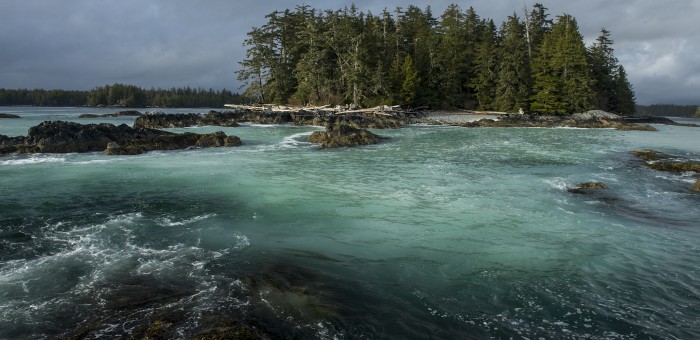



One Comment
There never will be a useful management of any sea stock with the Indians deliberately doing what they want, legal or not, until these so called fishing rights and selling of fish stocks 12 months a year continue we will never have a useful management plan, the continual ongoing rape of all these ocean and river fish of any species, wither Indian or other commercial fishery, our fish and fishery is doomed.